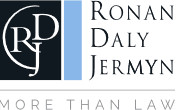Darryl Broderick: Court of Appeal slashes damages in ‘offer of amends’ defamation case

Darryl Broderick
Ronan Daly Jermyn partner Darryl Broderick and trainee solicitor Therese Collins review a significant reduction in an award made by a jury to a plaintiff in High Court defamation proceedings where an “offer of amends” had been made.
The Court of Appeal recently significantly reduced the award made by a jury to a plaintiff in High Court defamation proceedings where an “offer of amends” had been made. This is an important decision in particular for defendants who make an offer of amends pursuant to Section 22 of the Defamation Act. An offer of amends is a means by which defendants in defamation proceedings can minimise their financial exposure as by making such an offer the Courts, if called upon to assess damages, will generally discount the damages that would otherwise be awarded.
Facts
Mr. Higgins, who was the Respondent in these appeal proceedings, is a senior commercial airline pilot employed by Aer Lingus. In April 2013, the respondent travelled to Italy with a friend to collect two microlight aircrafts to fly them back to Ireland. The journey back to Ireland was planned to take place in stages over a number of days via the United Kingdom. However, both aircraft had to make an emergency landing near Swansea due to issues with poor visibility. In compliance with legal requirements, the respondent notified local police and the Air Accident Investigation Bureau in the UK (AAIB). The AAIB notified the UK Civil Aviation Authority. The UK CAA proceeded to open an investigation into the incident and notified the respondent of this investigation on 11 July 2013.
The U.K. CAA concluded their investigation in July 2013 and informed the Respondent of their satisfaction that he had satisfied all of his requirements. Following conclusion of this investigation, the Respondent made a data access request of the appellant in these proceedings, the Irish Aviation Authority (IAA) and the UK CAA. The documentation that the Respondent received from the U.K. CAA on foot of this request included three emails which formed the basis of this case. It was the third of these emails that proved troublesome for the IAA and it contained the words:”… we still have a couple of issues to deal with this side of the Irish Sea so the two boys will not be getting away ‘scot free’.
The IAA had not disclosed these emails pursuant to the data access request and upon further enquiry from the Respondent, the IAA informed the Respondent that these had not been retained.
Defamation Proceedings were issued in April 2014. An offer of amends was ultimately sent to the Respondent in May 2015 A dispute arose between the parties as to whether, based on the wording of the Defamation Act it fell to a judge sitting alone or a judge sitting with a jury to determine damages once an offer of amends had been accepted. The High Court, the Court of Appeal and the Supreme Court all ultimately found that damages in these instances fell to be determined by a jury.
High Court Decision
Following the resolution of that question, the current proceedings came on for hearing in the High Court before Barton J. sitting with a jury in November 2019. The jury awarded the Respondent €300,000 in general damages and €130,000 in aggravated damages. Upon consideration of the offer of amends, the jury afforded the IAA a 10% discount, which resulted in an overall total of €387,000.
Court of Appeal Decision
The IAA appealed the decision on the grounds that the awards of both general and aggravated damages were “unreasonable, excessive and disproportionate” and furthermore that the level of discount awarded to the IAA was deficient, in all the circumstances. The Court of Appeal considered the decision of the same court in Christie v TV3 Television Networks Limited [2017] IECA 128, which was the first case where the Irish Courts had to consider the appropriate discount on damages, where an offer of amends has been made. In that case, Hogan J. in the Court of Appeal allowed a discount of 40 per cent on damages in recognition of a swift and prominent apology by TV3. Referring to both Christie and John v. M.G.N. Ltd. [1997] Q.B. 586, Binchy J. acknowledged the well-established concept that appellate courts should be reluctant to amend awards made by a jury in a defamation action unless the award is “so unreasonable as to be disproportionate to the injury sustained” and “one which no reasonable jury would have made in the circumstances”.
Binchy J. considered a number of factors in his decision. Firstly, the judge considered the effect of the publications on the Respondent. The Respondent claimed that on foot of these publications, he became stressed and feared losing the career he had built as a pilot and losing the ability to provide for his children. The IAA contended that the emails had no impact on the Respondent’s employment because he had since secured a more senior position within Aer Lingus. The judge concluded that the emails did not have an adverse impact on the Respondent’s career nor his personal life save for the mental distress, which Binchy J. opined, should not be treated lightly.
Secondly, Binchy J. considered the nature and gravity of the Defamation. The Judge was at pains to point out that he did not underestimate the worry and distress caused to the Respondent in this instance and acknowledged that the nature and gravity of the defamation was of a most serious nature. However, comparing this case to Leech v Independent Newspapers [2007] IEHC 223 and Christie where, as the Judge outlined, “the plaintiffs suffered dreadful consequences from the defamatory publications”. Binchy J. concluded that the emails had no practical consequences for the Respondent and this was, in itself adequate to conclude that the amount of damages awarded by the jury was disproportionate to the injury experienced.
Binchy J. considered the extent of the publication of the emails, which were communicated to five people. The third email was sent solely to Mr. Webb of the U.K. CAA. Binchy J. acknowledged that while there could be circumstances where an award of damages would be reduced based on limited circulation of a publication; this could be counterbalanced depending on the identity of the recipients.
The judgment noted that this was the first case where a jury was provided with information on awards in other defamation cases as well as the maximum level of general damages in personal injury cases and acknowledged that because defamation cases have such varied circumstances; this would have been of limited use. The court also acknowledged that the award of the High Court jury, if allowed to stand, would be the second highest award in a defamation case in Irish legal history. Binchy J. was of the opinion that €70,000 was an appropriate compensatory sum for the Respondent, considering the damage to the Respondent’s reputation, mental distress caused to the Respondent and while the distribution of the publications was limited, the identity of the recipients was significant. The Judge also awarded the Respondent €15,000 in aggravated damages and noted that the conduct of the IAA was considered in determining this figure.
With regard to a suitable discount to be applied to this award of damages, Binchy J. considered the conduct of the IAA who refused to meet the Respondent following the Respondent’s refusal of the IAA’s offer of compensation and noted that this could hardly be described as “conciliatory conduct” as foreseen by the Defamation Act. Binchy J. chose not to increase the level of discount determined by the High Court and applied a 10% discount to the combined total of general and aggravated damages (€85,000) which resulted in an award in favour of the Respondent in the amount of €76,500.
Comment
There are a number of points of note for both defamation claimants and defendants in this decision, as follows:
-
While there was concern that the fact that a plaintiff can elect to have a jury determine damages even where a defendant has made an offer of amends might dilute the usefulness of the offer of amends as a means of resolving defamation claims, this decision demonstrates a willingness on the part of the appellate courts to overturn disproportionate jury awards. The offer of amends therefore is still a useful tool for attempting to resolve defamation claims particularly where a defendant has no good defence to the claim;
-
It offers guidance on the discounts that might be applied to damages awards when this procedure is used. Those discounts are currently ranging between 10 and 40%;
-
It was the first case where a jury in a defamation case appears to have been given substantive directions on damages, albeit the usefulness of that exercise must be questionable after the jury’s award in this case;
-
It sets a level of damages that will act as somewhat of a benchmark in cases where there is limited communication of a defamatory statement, albeit in this instance the damages awarded were high because the court perceived the defamatory statement to be of a particularly serious nature in the circumstances given the recipients of the emails.
It was also interesting to note that the IAA did not try to rely on a “qualified privilege” defence, which often would be relied on where communications are limited e.g. emails to a person or group of people with interest in the subject of the email. In this instance, it seems that the nature of the troublesome email was such that the IAA’s lawyers considered that they would not succeed with such a defence.

- Darryl Broderick is a partner and head of litigation and dispute resolution at Ronan Daly Jermyn. Therese Collins is a trainee solicitor.








